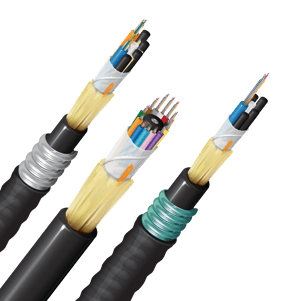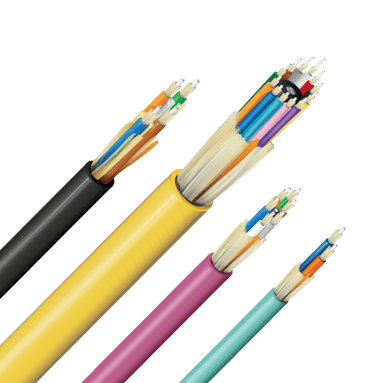-2.jpeg?width=4742&name=AdobeStock_119913056%20(1)-2.jpeg)
Fiber optic cables are invaluable to today’s networks and infrastructure due to their long-distance capabilities, fast speeds, superior reliability and future-proof performance.
To support the next generation of technology, different fiber cable types are used across enterprise applications, smart buildings, data centers and indoor/outdoor industrial environments. It’s critical you find the right fiber cable type to meet your application’s requirements.
Loose Tube Cables

These cables are designed to be buried directly in the ground or in a duct, so they can handle uncontrolled temperatures and outdoor environments and/or moisture. They’re known as “loose tube cables” because the buffer (the protective coating over the fiber) is loose.
Central loose tube cables tend to be smaller in diameter, while multi loose tube cables are larger in diameter. Your specific application’s requirements in terms of space and density will determine which type of loose tube fiber cable is the best option.
Distribution Fiber Cables
.png?width=333&name=Belden-Fiber-Distribution-Family-Fanout%20(1).png)
Distribution fiber cables are engineered for backbone applications that move signals back and forth between equipment rooms, entrance facilities and telecommunications rooms.
Mini distribution fiber cables are a miniaturized version of the standard distribution fiber cables and have the added benefit of increasing fiber density while taking up less space. These cables are ideal for data center applications.

All-Dielectric Self-Supporting Fiber Cables
ADSS Fiber Cables are used primarily outdoors. These cables can support themselves – they are often strung between structures (like poles) without any conductive metal elements like lashing wires.
Made with materials that can endure hanging installations for longer periods of time, ADSS fiber cables can also withstand rugged conditions. From outdoor hazards such as wind and ice to vibrational forces and lightning, they can continue to maintain signal performance.
Breakout Fiber Cables

Breakout fiber cables can be used for intra- and inter-building backbones, as well as for junction boxes, patch panels and conduits, and on factory floors. These cables contain “breakout units”. In addition to having their own jackets, these breakout units are also encased in an overall jacket, making the overall cable able to better handle rugged conditions.
Ribbon Fiber Cables
Ribbon cable is an ideal option for high-density environments, where installers need to complete large workloads in a small space.
Traditionally, each fiber in a cable had to be connectorized or spliced, which took up valuable time; however, because ribbon cable arranges 4, 8 or 12 fibers into a flat strip, these cables can be terminated much more quickly.

Picking the Right Fiber Cable Type For You
To find the right fiber cable for your environment, you will need to find a balance between cost, application needs and timelines.
Belden’s fiber solutions are built for easy installation, various density requirements and on-demand scalability. Paired with our collaborative approach, we have the solutions and expertise to meet the requirements of any project.

Resources
Topics:
Fiber optic cables
Belden
fiber guide
enterprise
smart building
-2.jpeg?width=4742&name=AdobeStock_119913056%20(1)-2.jpeg)
.png?width=333&name=Belden-Fiber-Distribution-Family-Fanout%20(1).png)






.png?width=58&height=58&name=X_logo_2023_(white).png)
